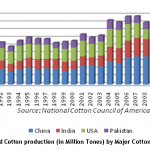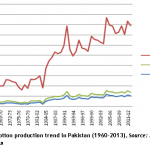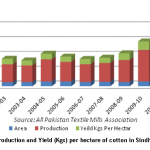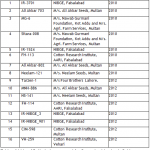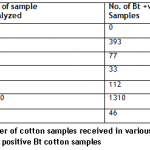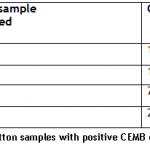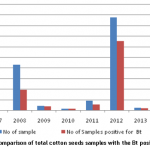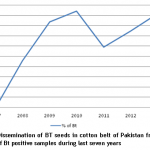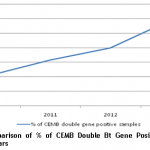Research Article
Dissemination of Bt cotton in cotton growing belt of Pakistan
Saira Azam1, Tahir Rehman Samiullah1, Aneela Yasmeen1, Salah ud Din1, Adnan Iqbal1, Abdul Qayyum Rao1, Idrees Ahmad Nasir1, Bushra Rashid1, Ahmad Ali Shahid1, Munir Ahmad2, Tayyab Husnain1
Adv. life sci., vol. 1, no. 1, pp. 18-26, November 2013
*-Corresponding Author: Dr. Abdul Qayyum Rao (Email: qayyumabdul77@yahoo.com)
Author Affiliations
2-Ali Akbar Seed Company, 1 km Bhoptian Chowk Defence Road off Raiwind Road, Lahore – Pakistan
Abstract
Introduction
Methods
Results
Discussion
References
Abstract
Background: Adoptability of biotech crops has climbed up dramatically in the world from 1.7 million hectares in its introductory period in 1996 to 170 million hectare in 2012. Area planted to biotech crop increased to over one-fourth of the world total in 2005-06. The data collected also demonstrates that developing countries like Pakistan are making tremendous development in production of Biotech crops especially cotton.
Methodology: Random samples have been collected and received from different cotton growing areas of Pakistan from 2007 to date for Bt gene confirmation and expression. Genomic DNA was isolated and analyzed through internal reference primers from SadI gene of cotton genome. Samples were analyzed by PCR for detection of Bt genes including CEMB Cry1Ac+2A double Bt gene. ELISA was done for confirmation of Bt protein by using Envirologix Quantiplate ELISA kit Cry1Ab/Ac Cat # AP003 and Quantiplate ELISA kit Cry2A Cat # AP005 according to manufacturer instruction.
Results: Development of Bt Cotton in Pakistan is as old as in advanced countries of the world. Pakistan has become the fourth country of the world for production of indigenous Bt cotton by utilizing their local cotton varieties for genetic modifications. The support of various documentary proofs like research articles, patents, projects, Ph. D and M.Phil studies generated by Centre of Excellence in Molecular Biology (CEMB) greatly strengthen the data of Bt cotton development in Pakistan. Pakistan Central Cotton Committee (PCCC) declared locally developed Bt cotton as the best performing of all over Pakistan among other international product.
Conclusion: Progress made in development of indigenous Bt cotton variety by CEMB Pakistan and their excellent performance in field determined their increased adoptability ratio in farmers. The formal approval process which is going to be completed in near future will open the doors for farmers and breeders to utilize this material for better economy of Pakistan.
Keywords: Bt cotton, Cry1Ac, Cry2A, PCR, ELISA, Pakistan
Introduction
Cotton is the most important cash crop and backbone in developed as well as developing countries [1]. Cotton seed has the credit of being the oldest seed known so far. It is being cultivated since 3500 BC in Indus Valley. It was found near Bolan Pass in Baluchistan [2]. This crop is a good source of income for the farming community and textile industries as many countries are earning major GDP from cotton export. Cotton being source of income for more than 250 million people of world is the largest profit earning crop produced in the world [3]. Due to its economic importance Cotton has always received importance in Research and Development. Cotton is produced among 70 countries of the world but two third of it is cultivated in four major countries including China, US, India and Pakistan [4]. Figure 1 gives an insight regarding quantity of cotton produced by these countries from year 1980-81 to 2012-13.
Cotton is known as “White Gold”. It is one of the most important cash crops of Pakistan contributing major source of foreign exchange earnings. It accounts for 8.2 % of the value added in agriculture and about 2 % of the GDP. Pakistan has ranked as the 3rd largest exporter of Cotton as well as it also stands 2nd in Yarn export; 3rd in yarn production; 3rd in cloth export; and, 7th in Cloth production (Source: International Cotton Advisory Committee, Washington D.C., USA). Pakistan is the 4th largest consumer of cotton in the world. According to a rough estimate almost 26% of Pakistani farmers grow cotton. The economic survey of Pakistan shows that 2689 thousand hectares of area was used for growing cotton crop during 2010-2011. Figure- 2 shows a comparison of cotton production in Pakistan.
The cotton belt of Pakistan ranges across Punjab and Sindh provinces. The production of cotton in these 2 provinces in past years is shown in figure 3 & 4.
In Pakistan, major insects including Pink Boll worm (Pectinophora gossypiella), American Boll worm (Heliothis armigera), Army worm (Spodoptera lithura), Spotted Boll worm (Earius insulana/vitella) cotton and Lepidopteron infect cotton crop drastically. In agricultural system, crop protection was exclusively depended upon spectrum highly toxic agrochemicals and their broad spectrum use which has caused human health concerns and severe environmental problems. This situation provoked efforts to develop organic control measures for insects and their attack on crops [1]. Numerous distinctive opportunities are made possible by transgenic approaches to manage population of pest. However there are some prerequisites for above mentioned approach including proper inheritance, integration, and expression of transgenes to confer permanent resistance in crops against insects [5]. Defensive genes are present as constitutive part of the genome in different plant tissues or as defensive compounds produced when plant is attacked by pathogens and pests [6]. Many public and private sector institutes are working in developing new varieties and maintaining the cotton breeds. Each of such new varieties needs to get official approval before cultivation on large areas. The Pakistan Central cotton Committee (PCCC) is a national organization responsible for research on cotton and all its aspects. This committee is further co related to various bodies e.g. Federal Seed Certification and Registration Department (FSC&RD) and Expert Sub Committees which are performing many functions. Each new variety needs to go through the National Coordinated Varietal Trials (NCVT) conducted by PCCC. The varieties need to clear the DUS trails and bio-safety trials (in case of genetically modified crops) as well. Depending upon the trails results the variety is subjected to be approved or disapproved for official permission of cultivation by the respective provincial seed council.
Sixteen Bt cotton varieties developed by various public and privates institutes of Pakistan have been approved after following the set criteria (list given in table 1). A number of single gene Bt cotton varieties along with 10 varieties developed by CEMB double Bt gene (Cry1Ac+ Cry2A) namely; CEMB-02, CEMB-22, CEMB-33, CEMB-44, CEMB-55, CEMB 66, CA-12, CA-904, CA-919 and CR-333 are being evaluated by the PCCC, PSC, NBC etc. for varietal approval purposes.
Further thirteen single Bt gene cotton varieties namely VH-259, BH-178, CIM-599, CIM-602, FH-118, FH-142, IR-NIAB-824, IUB-222, Sayban-201, Sitara-11M, A-555, KZ-181 and Tarzan-2 including two varieties namely CA-12 and CEMB-33 containing CEMB double Bt genes have been recommended by Expert subcommittee Punjab, Pakistan in its 69th meeting held on 16-04-2013 for general cultivation in the Punjab Province. The Punjab Seed Council will consider these fifteen varieties for approval in its 44th meeting proposed to be held in the month of October-November 2013.
There are four labs which are responsible for testing of Bt contents of candidate varieties. These labs are part of following institutes:-
1. National Institute for Agricultural Biotechnology Research Institute Faisalabad (ABRI) , Faisalabad
2. Centre of Excellence in Molecular Biology (CEMB), Lahore
3. National Institute of Biotechnology and Genetic Engineering (NIBGE), Faisalabad
4. Genomics and Advanced Biotechnology (NIGAB), Islamabad
During last 5 years various samples were received in CEMB from different cotton institutes of Punjab and Sind. These were analyzed for their Bt content. The results of all such experiments have been compiled in this paper to show the increasing content of Bt protein in cotton belt of Pakistan. Moreover, the spread of CEMB Cry1Ac+2A was also analyzed in received samples and the results are also reported here.
Methods
Plant Material
Random samples have been collected and received from different cotton growing areas of Pakistan from 2007 to date for Bt gene confirmation and expression.
Plant genomic DNA extraction and quality confirmation
Genomic DNA was isolated from apical leaves of cotton plants (growing in the field) by using Intron Scientific G SpinTM IIP kit cat# 17271 and analyzed through internal reference primers from SadI gene of cotton genome.
Screening of samples through PCR
Genomic DNA of collected and received samples were analyzed by PCR for detection of Bt genes by amplification of internal fragments of Bt genes. These samples were analyzed for Cry1Ac and Cry 2A genes by using PCR as done in other reported studies [7,8]. Presence of CEMB Cry1Ac+2A double Bt gene was also done in these samples by using CEMB gene specific primers.
Expression analysis of cotton samples for Bt protein
The total proteins of all plants samples were isolated from apical leaves, Bradford assay was performed for estimation of total protein as done by Bradford [9]. ELISA was used to screen the plants for expression of Bt protein. Confirmation of Bt protein in samples was done by using Envirologix Quantiplate ELISA kit Cry1Ab/Ac Cat# AP003 and Quantiplate ELISA kit Cry2A Cat# AP005 according to manufacturer instruction.
Results
Samples were collected from different research institutes and breeding center since 2007 to 2012. The samples were tested for their Bt content via PCR and ELISA tests. The number of cotton samples received in various dates and the percentage of positive Bt cotton samples is given in table 2. From table 2 it is clear that Bt was not detected in received samples until 2007 but from year 2008 to date insect resistant gene was detected in various samples. A comparison of Bt cotton samples in various years is shown in graph 1 & 2. Graph 2 shows the increase of Bt cotton in cotton belt of Pakistan with the passage of time. CEMB GMO detection lab has also analyzed the presence of CEMB double Bt gene (Cry1Ac/2A) in various samples. The results of those tests are compiled in table 3.
Figure 5 determines the comparison of Bt cotton samples received in different years starting from 2007 to date. From the graph it is also cleared that maximum samples has been received in year 2012 which shows increase dissemination of Bt cotton with the passage of time. However the small bar in 2013 indicates that there are samples still to be analyzed in future years. Figure 6 represents the %age of cotton samples positive for Bt protein in different years. The continuous increase over last two years is also obvious from the graph. The discontinuity in graph line in years 2010 and 2011 was observed which reflects less percentage of Bt samples in cotton areas in these years.
Discussion
Cotton is the major export material earning sizable foreign exchange for Pakistan but its annual yield is decreasing due to many factors including H. Armigera attack as a major pathogen [6]. Using conventional plant breeding techniques, cotton breeders have continuously sought to improve the cotton which, in past century, has added number of different improved traits in crop yield. But in existing germplasm resistance against insect pests is not present; this has led transfer of new transgenes into plants to create plant varieties with novel characters through plant breeding techniques that’s why transgenic cotton expressing insecticidal proteins from B. Thuringiensis (Bt) has been one of the most rapidly adopted GM crops in the world [5]. Plants transformed with single Bt gene are liable to develop insect resistance and this has already been reported in a number of studies carried out around the world where Bt cotton was cultivated on commercial scale. Later, it was envisaged to transform plants with more than one Bt genes in order to combat with resistant larvae. This approach seems valid as various Bt genes possess different binding domains which could delay the likely hazards of insect resistance against a particular Bt toxin [10]. Many public and private institutes are working on development of Bt cotton. In transformation of virus resistant genotype of Gossypium hirsutum L., with pesticidal gene CEMB has developed protocol for cotton genetic modification as reported by different studies [11,12]. CEMB claims to have developed Bt cotton with both single and double gene and citation of many PhD studies right from 1996 to time, with nearly fifty research articles and five patents in support of this claim along with approval of their more than ten lines from National Bio-safety Committee hence strengthening their claim [2,5,13-19]. There is a set procedure for Bt variety to get approval. The variety has to pass through NBC approval process, two years DUS studies by the FSC&RD, two years field trial at all Pakistan level by the PCCC and one year trial at PSC Khanewal for spot examination by the expert team of scientists has also to be done before the case can be submitted to Punjab Seed Council for approval by expert subcommittee. Sindh Seed Council also follows same procedure for giving approval. So far, sixteen Bt Cotton varieties have been approved by Punjab Seed council; eight of them were approved in 39th meeting of Punjab Seed Council while the other eight are recently approved in 42nd Meeting of Punjab Seed Council (Punjab Seed Council, 2012). The details are given in table 02.Single gene varieties have been approved for cultivation in 2012. But the record of CEMB shows that Bt cotton was there in cotton belt of Pakistan since 2008.In Pakistan, insect resistant cotton was grown
on 2.4 million hectares out of 2.8 million hectares allocated land. In addition, the CEMB double Bt gene variety which got NBC approval/commercialization license in 2009 has been spread all over the cotton belt as shown in table 3 and graph 3 and also reported in different studies [1,3]. PhD dissertations along with number of M.Phil research dissertations have highlighted insect resistant cotton development in CEMB during these years [2,5,10,18].
In conclusion, from above discussion it is clear that development of Bt cotton in Pakistan is as old as from 1996 as the outcome comes in form of publication from these dates. Bt cotton introduction in Pakistan in the form of Single and double gene is not new but its local development and multiplication has introduced it very early and now the data reflects its limited spread all over Pakistan.
Moreover from CEMB data it is also clear that bio-safety trial of insect resistant plants having Bt genes singly and double Bt genes (CEMB 02 Events) has been started from early 2000 on different organisms including Mice, Fish, Earthworm, Chicks and Rabbits along with gene flow studies including horizontal and vertical gene flow which results in delaying their efforts to be brought in front of public. Thirteen years studies of risk assessment clearly demonstrate that CEMB-02 event is safe from risk point of view for all organisms.
The adaptability ratio of CEMB double Bt gene by farmers demonstrate the excellent performance of CEMB-02 event in farmers field as it is being transformed in local cotton varieties and it will prove to be milestone for farmers and breeders to develop new cultivars after its approval from Punjab seed council in near future.
References
- Bakhsh A, Rao AQ, Shahid AA, Husnain T, Riazuddin S. Insect resistance and risk assessment studies in advance lines of Bt cotton harboring Cry1Ac and Cry2A genes. American-Eurasian Journal of Agriculture and Environmental Science, (2009); 6(1): 1-11.
- Khan AI, Fu Y-B, Khan IA. Genetic diversity of Pakistani cotton cultivars as revealed by simple sequence repeat markers. Communications in Biometry and Crop Science, (2009); 4(1): 21-30.
- Chapagain A, Hoekstra A, Savenije H, Gautam R. The water footprint of cotton consumption: An assessment of the impact of worldwide consumption of cotton products on the water resources in the cotton producing countries. Ecological Economics, (2006); 60(1): 186-203.
- Sabir HM, Tahir SH, Khan MB. BT Cotton and its Impact on Cropping Pattern in Punjab. Pakistan Journal of Social Sciences (PJSS), (2011); 31(1): 127-134.
- Rashid B, Saleem Z, Husnain T, Riazuddin S. Transformation and inheritance of Bt genes inGossypium hirsutum. Journal of Plant Biology, (2008); 51(4): 248-254.
- Majeed A, Makhdoom R, Husnain T, Riazuddin S. Assessment of potato proteinase inhibitor-II gene as an antifungal and insecticidal agent. Acta Agriculturae Scandinavica Section B–Soil and Plant Science, (2011); 61(1): 92-96.
- Bashir K, Husnain T, Fatima T, Latif Z, Mehdi SA, Riazuddin S. Field evaluation and risk assessment of transgenic indica basmati rice. Molecular Breeding, (2004); 13(4): 301-312.
- Rao AQ, Bajwa KS, Puspito AN, Khan M, Abbas MA, Rehman M, Baksh A, Shahid AA, Nasir IA, Husnain T. Variation in Expression of Phytochrome B Gene in Cotton (Gossypium hirsutum L.). Journal of Agricultural Science and Technology, (2013); 15(5): 1033-1042.
- Bradford MM. A rapid and sensitive method for the quantitation of microgram quantities of protein utilizing the principle of protein-dye binding. Analytical Biochemistry, (1976); 72(1): 248-254.
- Kiani S, Mohamed BB, Jamal A, Shahid MN, Shehzad K, et al. Chloroplast-targeted Expression of Recombinant Crystal-protein Gene in Cotton: An Unconventional Combat with Resistant Pests. Journal of Biotechnology, (2013).
- Rao AQ, Bakhsh A, Kiani S, Shahzad K, Shahid AA, et al. The myth of plant transformation. Biotechnology advances, (2009); 27(6): 753-763.
- Rao AQ, Irfan M, Saleem Z, Nasir IA, Riazuddin S, et al. Overexpression of the phytochrome B gene from Arabidopsis thaliana increases plant growth and yield of cotton (Gossypium hirsutum). Journal of Zhejiang University SCIENCE B, (2011); 12(4): 326-334.
- Riaz N, Husnain T, Fatima T, Makhdoom R, Bashir K, et al. Development of Indica Basmati rice harboring two insecticidal genes for sustainable resistance against lepidopteran insects. South African Journal of Botany, (2006); 72(2): 217-223.
- Maqbool SB, Riazuddin S, Loc NT, Gatehouse AM, Gatehouse JA, et al. Expression of multiple insecticidal genes confers broad resistance against a range of different rice pests. Molecular Breeding, (2001); 7(1): 85-93.
- Majeed A, Husnain T, Riazuddin S. Transformation of Virus-Resistant Genotype of Gossypium hirsutum L. with Pesticidal Gene. Plant Biotechnology, (2000); 17(2): 105-110.
- Husnain T, Asad J, Maqbool SB, Datta SK, Riazuddin S. Variability in expression of insecticidal Cry1Ab gene in Indica Basmati rice. Euphytica, (2002); 128(1): 121-128.
- Zia-ur-Rehman I, Zafar AU, Nasir IA, Riazuddin S. Comparative study of Bacillus thuringiensis biopesticides against cotton bollworms. Asian Journal of Plant Sciences, (2002); 1(5): 574-576.
- Bakhsh A, Rao AQ, Shahid AA, Husnain T, Riazuddin S. CaMV 35S is a developmental promoter being temporal and spatial in expression pattern of insecticidal genes (cry1ac & cry2a) in cotton. Austerlain Journal of Basic and Applied Sciences, (2010); 4(1): 37-44.
- Bakhsh A, Rao AQ, Shahid AA, Husnain T. Spatio Temporal Expression Pattern of an Insecticidal Gene (cry2A) in Transgenic Cotton Lines. Notulae Scientia Biologicae, (2012); 4(4): 115-119


